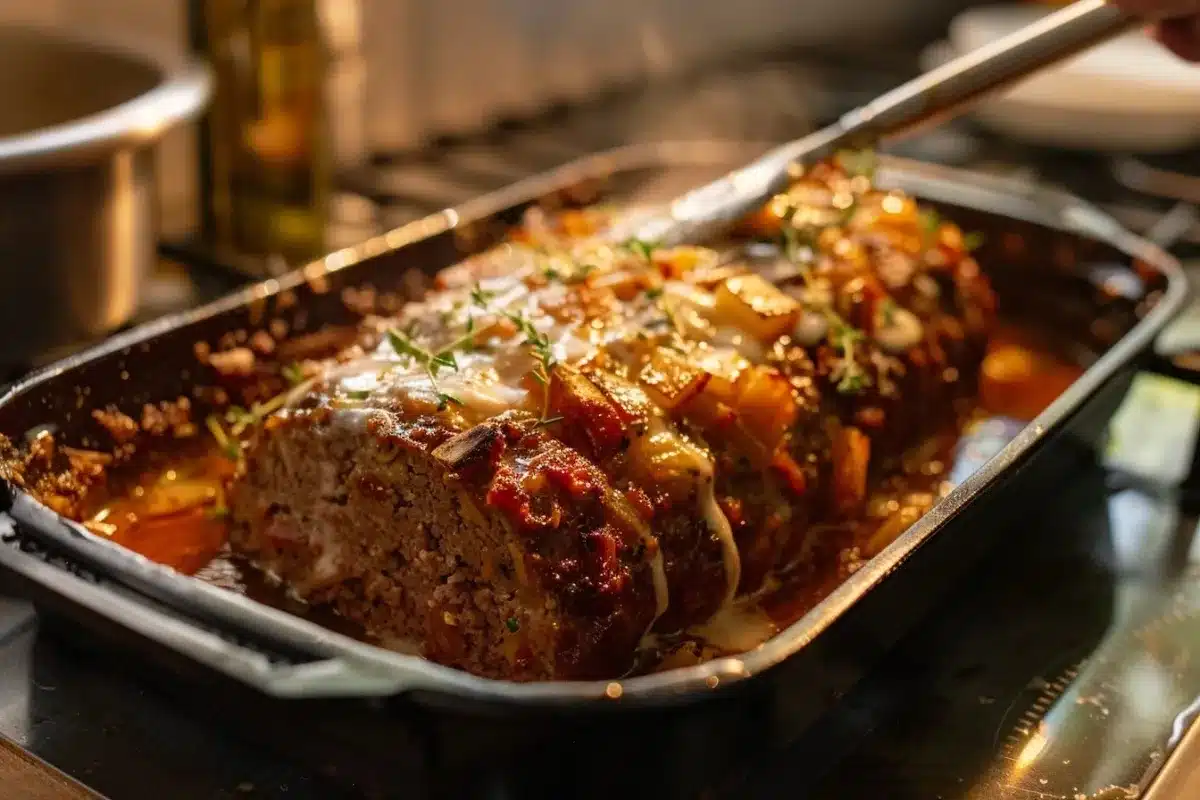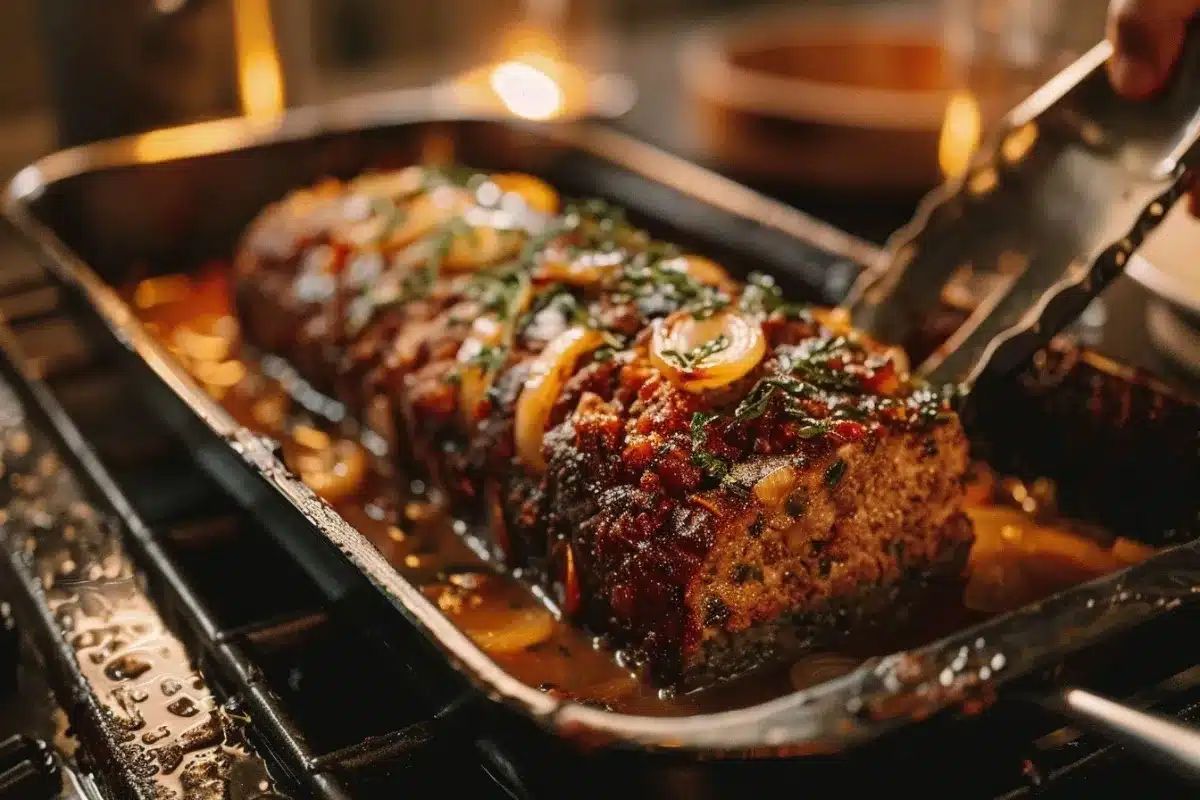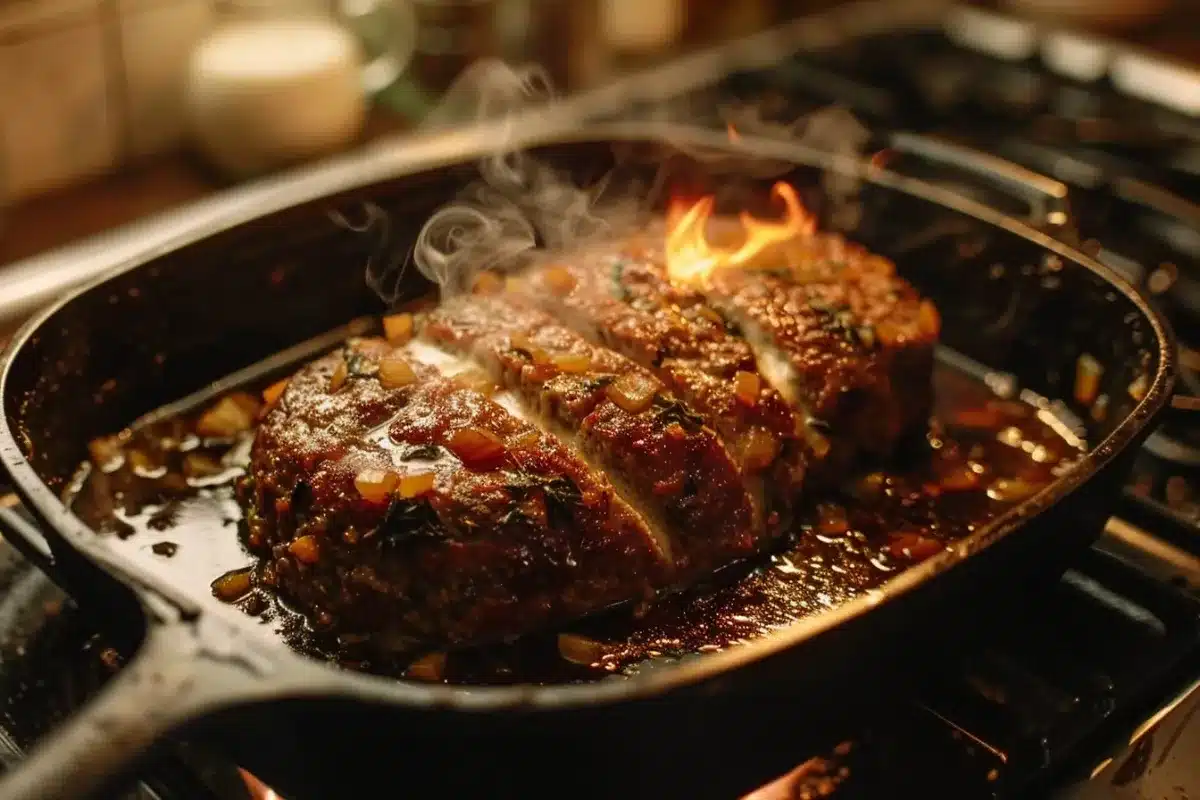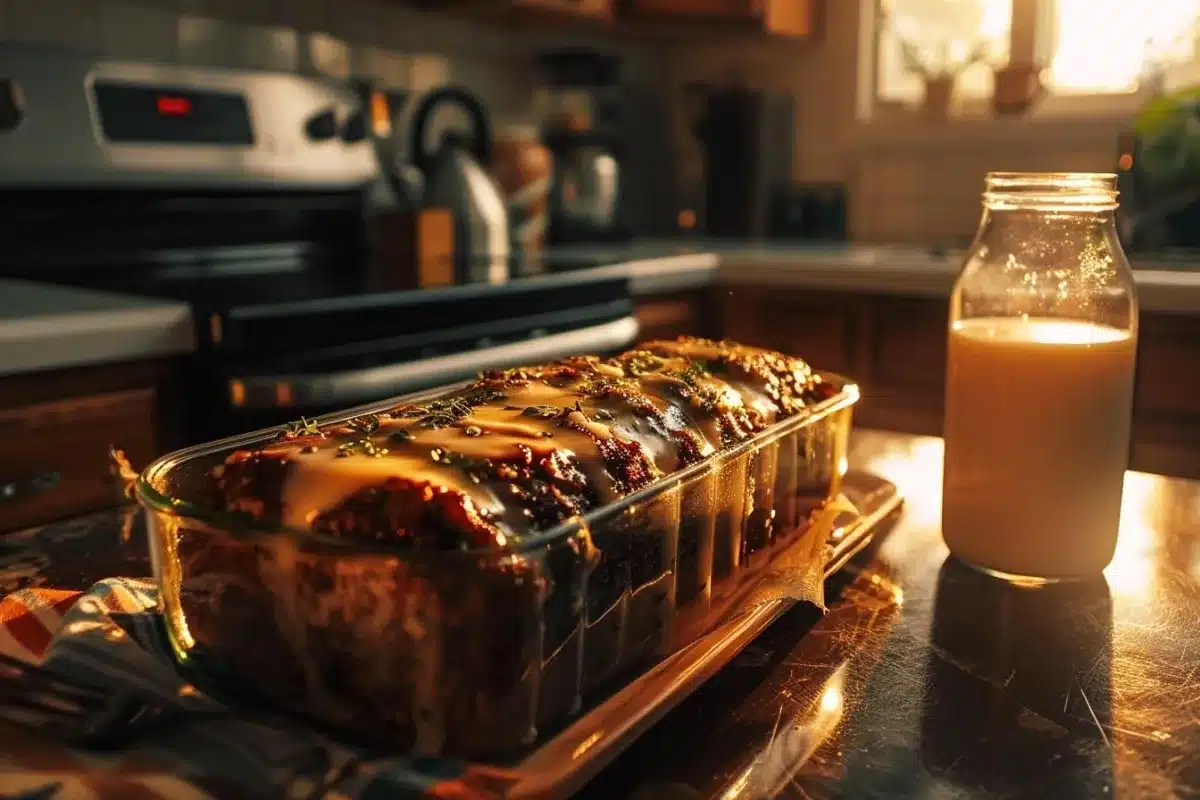Certainly, let’s delve into the specifics. The key to a perfectly moist and tender meatloaf often lies in the liquid we choose. This article will, therefore, explore why milk is frequently favored over water in meatloaf recipes.
The Science Behind Milk in Meatloaf
The inclusion of liquids is undeniably vital to the meatloaf‘s structure and texture. However, not all liquids perform equally. We will, naturally, explore why milk stands out.
The Role of Liquids in Meatloaf
Firstly, liquids play a pivotal role in keeping meatloaf moist. They also help bind the ingredients together. Furthermore, these liquids enable even cooking. In addition, they contribute to a tender final product.
Why Milk Is Preferred
Milk is preferred because of its unique composition. It contains fat and proteins. Consequently, these components significantly enhance the meatloaf’s texture. Therefore, milk creates a richer, more tender meatloaf.
The Composition of Milk
Milk, therefore, is not just water. Moreover, it is a complex emulsion. It contains water, fats, proteins, and sugars. These elements, consequently, interact with the other meatloaf ingredients. Thus, this interaction creates a more flavorful and tender product.
How Fat in Milk Impacts Meatloaf
The fat content in milk is especially important. It contributes to the overall moisture and richness. Moreover, fat prevents the meatloaf from becoming dry. Therefore, this ensures a much more palatable final result.
Proteins in Milk and Binding
Additionally, the proteins in milk also act as a binder. Consequently, they help hold the meatloaf together. This binding, therefore, is essential to avoid a crumbly texture. Furthermore, these proteins contribute to a cohesive and firm meatloaf.
Milk vs. Water: A Detailed Comparison
Comparing milk to water provides a clearer view. Therefore, it highlights the advantages of using milk in meatloaf.
Lack of Fat and Protein in Water
Water, in contrast, lacks both fat and protein. Consequently, it can lead to a drier and less flavorful meatloaf. Moreover, water does not provide the same binding effect as milk. Therefore, it can result in a less cohesive texture.
How Water Affects the Meatloaf
Using water can, therefore, cause the meatloaf to be dense and compact. Furthermore, it lacks the tenderness that milk provides. Therefore, water is generally considered an inferior choice for creating a tender meatloaf.
Texture and Flavor Differences
The difference in texture and flavor is especially noticeable. Milk adds a creamy texture and a subtle richness. On the other hand, water, provides neither. Thus, the difference is clear.
Tenderness Comparison
The meatloaf made with milk will, therefore, be significantly more tender. Consequently, the fat in milk works to keep the fibers of the meat soft. Moreover, water does not provide this benefit, thereby resulting in a chewier texture.
Other Liquids for Meatloaf: Exploring Alternatives
While milk is generally preferred, other liquids can also be used. Therefore, let’s explore these alternatives.
Broth and Stock
Broth and stock are common alternatives to milk. Consequently, these liquids add flavor and moisture. However, they often don’t have the fat content of milk. Therefore, the texture may vary.
Types of Broth to Use
Beef or chicken broth is commonly used. These add a savory depth to the meatloaf. Therefore, they can be a suitable substitute.
Vegetable Broth Options
Furthermore, vegetable broth can also be used. This option is particularly useful for vegetarians. Moreover, it adds a subtle and pleasant flavor.
Other Dairy Substitutes
Moreover, dairy alternatives like buttermilk can also be used. Buttermilk, likewise, provides a slight tanginess and richness. It is therefore, an effective alternative.
The Role of Eggs in Meatloaf
Eggs are another crucial binding agent. Consequently, they help to hold the meatloaf together. In addition, they contribute to the overall moisture. Therefore, eggs are a vital ingredient in most recipes.
Enhancing Meatloaf Flavor and Moisture
Beyond the liquid, other ingredients enhance both the flavor and moisture. Therefore, we’ll explore several options.
Breadcrumbs and Binding
Breadcrumbs, for example, are essential for texture. They absorb the liquids. Furthermore, they help bind the meatloaf together. Therefore, they create a more cohesive structure.
The Role of Vegetables
Finely chopped vegetables also add moisture. Onions, peppers, and carrots are all great choices. Therefore, they enhance both flavor and texture.
Adding Flavor with Spices and Herbs
Spices and herbs add depth and complexity to the meatloaf. Therefore, they enhance the overall taste. Salt, pepper, and garlic powder are staples. However, you can experiment with other herbs and spices.
Using Different Types of Meat
The type of meat can, furthermore, impact moisture levels. A mix of beef, pork, and veal is common. Therefore, it provides a balance of flavor and fat.
Practical Tips for Making Moist Meatloaf
To make a moist meatloaf, following specific tips is helpful. Therefore, these tips will ensure the best outcome.
Avoid Overmixing
Overmixing can result in a dense meatloaf. Therefore, mix until just combined. This careful approach ensures a tender texture.
Baking Temperature and Time
The baking temperature and time also play a crucial role. Baking at the right temperature is essential. Moreover, ensure it is cooked through.
Using a Meat Thermometer
A meat thermometer is especially helpful. It allows you to check the internal temperature. Therefore, it ensures that the meatloaf is cooked to the correct doneness.
Allowing the Meatloaf to Rest
Allowing the meatloaf to rest after baking is also important. It allows the juices to redistribute. Furthermore, this ensures a moist and flavorful final result.
Serving Suggestions
Serve meatloaf with mashed potatoes or a green salad. These are classic pairings. Therefore, they provide a balanced meal.
Troubleshooting Common Meatloaf Problems
Sometimes, things can go wrong. Therefore, let’s address some common meatloaf problems.
Dry Meatloaf
Dry meatloaf is a common issue. Consequently, it can often be fixed by adding more liquid or fat. Therefore, using the correct milk amount is essential.
Crumbly Meatloaf
A crumbly meatloaf can result from insufficient binders. Consequently, this can be addressed by adding more eggs or breadcrumbs. Therefore, balancing the ingredients is crucial.
Meatloaf Falling Apart
A meatloaf falling apart may indicate a lack of binding ingredients. Consequently, adding more breadcrumbs, eggs, or milk can improve it. Therefore, ensuring proper ingredient ratios is key.
Meatloaf is Too Dense
Overmixing can make meatloaf too dense. Hence, mix gently and only until combined. Therefore, careful mixing is vital to a good meatloaf.
Making Meatloaf With Different Diets
The versatility of meatloaf allows for various dietary adjustments. Therefore, adaptations to suit different diets can be made.
Gluten-Free Meatloaf
Gluten-free breadcrumbs or oats can be used. Consequently, this makes the meatloaf gluten-free. Therefore, gluten-sensitive people can also enjoy meatloaf.
Dairy-Free Options
For dairy-free options, non-dairy milk can be used. Therefore, plant-based options can work quite well. Oat or almond milk can be great substitutions.
Low-Carb Meatloaf
Low-carb options often use almond flour or crushed pork rinds. Therefore, low-carb alternatives are also available. Additionally, this allows for more diverse diets.
Vegetarian Meatloaf
Vegetarian meatloaf uses lentils, beans, or mushrooms. Therefore, this makes meatloaf suitable for vegetarians. Moreover, these alternatives are delicious.
The Best Milk for Meatloaf: A Comparison
Not all milk is created equal. Therefore, let’s look at how different milk types influence the final dish.
Whole Milk
Whole milk is a great option. It has a high-fat content. Consequently, this creates a very tender and rich meatloaf. Therefore, it’s often a preferred choice.
2% Milk
2% milk offers a good balance. It has less fat than whole milk, but still enough to provide moisture. Therefore, it’s a suitable alternative.
Skim Milk
Skim milk has little to no fat. Therefore, it may lead to a drier meatloaf. Thus, it is less ideal for optimal results.
Plant-Based Milk Alternatives
Plant-based milk options offer unique results. Therefore, they are good alternatives for various diets. Almond, soy, and oat milk are common choices.
Milk Fat Content and Meatloaf Texture
The fat content of the milk directly impacts the texture. Consequently, higher fat content usually leads to a more tender result. Therefore, choose milk based on your preference for tenderness.
Table: Milk vs Water in Meatloaf
| Feature | Milk | Water |
| Fat Content | Contains fat, enhancing moisture | Lacks fat, may lead to dryness |
| Protein Content | Contains protein, aids in binding | Lacks protein, less binding ability |
| Texture | Creates a more tender meatloaf | Can result in a dense, dry meatloaf |
| Flavor | Adds richness and subtle creaminess | Adds no flavor and can make it bland |
| Binding Ability | Improves meatloaf cohesion | Does not bind ingredients effectively |
Table: Common Meatloaf Liquids Compared
| Liquid | Flavor Profile | Moisture Content | Texture Impact |
| Milk | Rich, creamy | High | Tender, moist |
| Water | Bland | High | Can be dry, dense |
| Beef Broth | Savory, Umami | Moderate | Adds depth, can be dense |
| Chicken Broth | Savory, Mild | Moderate | Adds flavor, can be slightly dry |
| Buttermilk | Tangy, slightly rich | High | Tender, slightly tangy |
| Plant-based Milk | Variable, depends on the type. | High | Depends on type, may be light |
Conclusion: The Power of Milk in Meatloaf
In summary, the choice of liquid significantly affects meatloaf. Milk, therefore, with its fat and protein content, creates a far superior result. Additionally, it leads to a much more tender and flavorful meatloaf. Water, conversely, lacks the necessary components. Thus, milk is the better choice for perfect meatloaf. Therefore, using milk ensures a moist and delicious dish every time. Finally, understanding the role of ingredients enhances cooking.
Frequently Asked Questions (FAQs)
Why do people add milk to their meatloaf?
People add milk to their meatloaf primarily to increase moisture and tenderness. Therefore, it helps the meatloaf bind together better and prevents it from drying out during cooking. Also, the fat in milk adds richness and flavor.
What is the secret to a great meatloaf?
The secret to a great meatloaf involves several key factors. Firstly, using the right ratio of ingredients, like a balance of meat, breadcrumbs, and liquids. Additionally, avoiding overmixing the meat is crucial to prevent a dense texture. Moreover, using milk instead of water helps retain moisture. Finally, proper baking time and temperature, along with resting it after cooking, will enhance flavor and texture.
Can you use water instead of milk in meatloaf?
Yes, you can use water instead of milk in meatloaf, but it will likely result in a drier and less flavorful dish. Since water lacks the fat and proteins that milk provides, the meatloaf might not bind as well. Therefore, the result may be less tender and might have a blander taste.
What ingredient keeps meatloaf from falling apart?
The ingredients that help keep meatloaf from falling apart are typically binding agents. Eggs and breadcrumbs play a key role in this. Also, milk helps create a cohesive texture. Therefore, a good balance of these ingredients will give the meatloaf a firm and cohesive structure.



